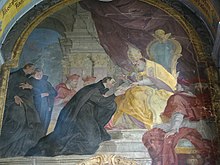Johann Christoph Handke
Johann Christoph Handke (also Hantke, Handtke, Hancke, Hanke, Hankhe , in Czech Jan Kryštof Handke ; born February 18, 1694 in Johnsdorf (Janušov) near Römerstadt , Margraviate of Moravia ; † December 31, 1774 in Olomouc ) was a Baroque painter who lived in Moravia, Bohemia and Silesia worked.
Life
Handke began an apprenticeship as a painter in 1708 with the Freudenthal painter Daniel Langer. From 1713 he worked as an assistant to the painter Christian David in Mährisch Trübau and from 1715 to Ferdinand Naboth in Olomouc , where he acquired citizenship in 1722 . A year later he was accepted into the painters' guild . After the death of his master Naboth, he continued his workshop and in 1724 he married his widow, whose name is not known. The marriage resulted in their daughter Paulina, who was born in 1728.
His first independent commission was in 1715 to complete the painting of the Linden Church ( Kostel v lipkách ) near Römerstadt, which had been started by his master Ferdinand Naboth. There he immortalized himself with a self-portrait ( man with slouch hat ). Until 1728 he was mainly active in Olomouc and the surrounding area. In the following years he received several orders from the Jesuits . In 1728 he frescoed the refectory in the Troppauer Kolleg and in 1730, together with his student Johann Franz Hoffmann, he painted the Königgrätzer Jesuit Church. In 1732 he frescoed the ceiling in the Aula Leopoldina and the Oratorium Marianum in the then Jesuit University of Breslau , which the artists Franz Joseph Mangoldt , Felix Anton Scheffler and Johann Albrecht Siegwitz were also involved in decorating . In 1733 Handke was busy painting the refectory in the Glogau Jesuit College. He also created many portraits of emperors, popes and bishops as well as altar and saint paintings.
After the death of his wife in 1742, Handke married Maria Veronika Sadler († 1755), a daughter of the Tyrolean sculptor Philipp Sadler . From this marriage came the son Johannes Josephus, who also became a painter. Another son and daughter Johanna Franziska Aloisia died in the child and youth altar. After the death of Maria Veronika in 1755, Handke remarried to a widow in the same year, who however left him after a year.
Handke was an unusually productive and successful fresco painter. In the years between 1715 and 1755 he verifiably created 80 frescoes or fresco cycles, some of which are no longer preserved. His colleagues included Johann Georg Etgens , Karl Franz Joseph Haringer and the Jesuit Johannes Kuben .
Autobiography
Handke wrote a self-biography of his artistic work, in which he also addresses the problematic relationship between the artist and the client with regard to appropriate remuneration. It was published in 1911 under the title Johann Christoph Handke's autobiography as a Festschrift of the Silesian Society for Patriotic Culture by Richard Foerster in the Breslauer Verlag Graß, Barth and Comp. published. The festschrift also contains a copy of the self-portrait from the Römerstadt Linden Church.
Other works (selection)
- Gieben : Altarpieces and 14 wall and vaults (1723)
- Sternberg : Winter refectory in the former Augustinian monastery (1728)
- Krönau : Altar painting (1729)
- Hradisch Monastery : room in the new monastery building (1728), ceiling painting in the monastery church (1730)
- Mährisch-Neustadt : Lady Chapel in the Minorite Monastery (1730)
- Holy Mountain Olomouc: side altar painting and refectory (1733)
- (1737/39)
- Velké Losiny castle : painting of the castle chapel (1742)
- Starnau : main altar painting (1748)
literature
- Constantin von Wurzbach : Hanke, Johann Christoph . In: Biographisches Lexikon des Kaiserthums Oesterreich . 7th part. Imperial and Royal Court and State Printing Office, Vienna 1861, p. 315 ( digitized version ).
- Günther Grundmann: Handke (Hanke), Johann Christoph. In: New German Biography (NDB). Volume 7, Duncker & Humblot, Berlin 1966, ISBN 3-428-00188-5 , pp. 606-608 ( digitized version ).
- Dehio Handbook of Art Monuments in Poland. Silesia. Deutscher Kunstverlag, Munich et al. 2005, ISBN 3-422-03109-X , pp. 66 and 1080.
- Ludwig Petry and Josef Joachim Menzel (eds.): History of Silesia . Volume 2, ISBN 3-7995-6342-3 , p. 193.
- Milan Togner: Jan Kryštof Handke 1694-1774. Malířské dílo . Olomouc: Muzeum umění Olomouc, 1994. 80 p. ISBN 80-85227-12-6 .
Web links
- Literature and other media by and about Johann Christoph Handke in the catalog of the National Library of the Czech Republic
- Handke, Johann Christoph . In: East German Biography (Kulturportal West-Ost)
Individual evidence
- ↑ The statement in the NDB that it was the "(Kaiserlich Leopoldinisch-Carolinische) German Academy of Natural Scientists (Halle / Saale)" is incorrect.
| personal data | |
|---|---|
| SURNAME | Handke, Johann Christoph |
| ALTERNATIVE NAMES | Handke, Jan Kryštof (Czech); Hantke, Johann Christoph; Handtke, Johann Christoph; Hancke, Johann Christoph; Hanke, Johann Christoph; Hankhe, Johann Christoph |
| BRIEF DESCRIPTION | Moravian baroque painter |
| DATE OF BIRTH | February 18, 1694 |
| PLACE OF BIRTH | Johnsdorf, today Janušov, Rýmařov |
| DATE OF DEATH | December 31, 1774 |
| Place of death | Olomouc |



